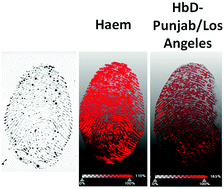Detection and mapping of haemoglobin variants in blood fingermarks by MALDI MS for suspect “profiling”†
Abstract
Over the past seven years Matrix Assisted Laser Desorption Ionisation Mass Spectrometry Profiling (MALDI MSP) and Imaging (MALDI MSI) have proven to be feasible tools for the detection of blood and its provenance in stains and fingermarks. However, whilst this capability as a confirmatory test addresses the primary questions at the scene of a violent crime, additional intelligence recoverable from blood can also prove important for investigations. A DNA profile is the most obvious and important example of such intelligence; however, it is not always suitable for identification purposes, depending on quantity, age and environmental conditions. Proteins are much more stable and determining the presence of haemoglobin variants in blood recovered at a crime scene may provide associative and possibly corroborating evidence on the presence of an individual at a particular location. This evidence gains more incriminatory value, the lower the incidence of the variant in a certain geographical area or population and may contribute to narrowing down the pool of suspects. In this study, a MALDI based mass spectrometric method has been developed and tested on six haemoglobin variants for their fast and reliable identification and mapping in blood fingermarks.



 Please wait while we load your content...
Please wait while we load your content...